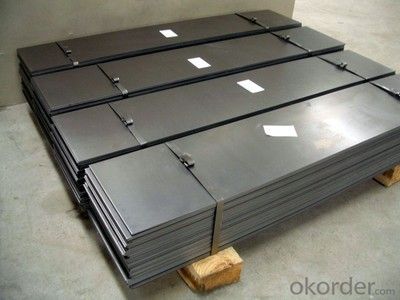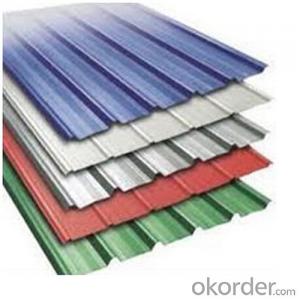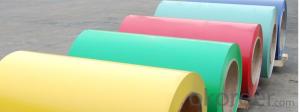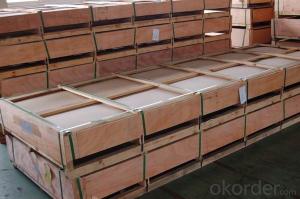Aluminum Galvanized Steel Coil Plate for Silo
- Loading Port:
- Qingdao
- Payment Terms:
- TT or LC
- Min Order Qty:
- 10 m.t.
- Supply Capability:
- 1000 m.t./month
OKorder Service Pledge
OKorder Financial Service
You Might Also Like
Aluminum Galvanized Steel Coil Plate for Silo
Structure of Aluminum Steel Coil
Products | GI/GL | PPGI/PPGL | CR | Corrugated Steel Sheet |
Grade | SGCC, CGCC, SPCC, ST01Z, DX51D, A653 | |||
Standard | JIS G3302 / JIS G3312 / ASTM A653M / A924M 1998 | |||
Origin | China(Mainland) | |||
Main Features of Aluminum Steel Coil
Raw material | SGCC, SPCC, DC51D, SGHC,A653, | |||
Certificate | ISO9001.ISO14001.OHSAS18001 | |||
Technique | hot rolled/ | pre-painted, hot rolled | cold rolled | pre-painted, hot rolled/cold rolled |
Thickness | 0.12mm-2.0mm | |||
Width | 600mm-1250mm | |||
Tolerance | thickness+/-0.01mm | |||
T Bending | ≤ 3T/4T | |||
Anti-MEK Wiping | 100times | |||
Zinc coating | ≤275g /m2 | |||
Color options | RAL Color System or as per buyer’s color sample. | |||
Type of | 2/1 or 2/2 coating, or customized | 2/1 or 2/2 coating, or customized | ||
Coil weight | 3-8MT | 3-8MT | 12-13MT | 3-8MT |
Type | Coil or Plate | |||
Spangle | big / small / no spangle | |||
Hardness | Soft---full hard | |||
FAQ
Q:Why should you choose us?
A:Chose happens because of quality, then price, we can give you both. Additionally, we can also offer professional products inquiry, products knowledge train (for agents),
Quick goods delivery, our factories locate near the seaport, which is very convenient for transportation.
Pictures:


- Q:My new home has a mix of copper and aluminum wiring. My mother used a shop vac in one of the recepticles last week and blew two of them in my bedroom. Then this weekend my brother was replacing my exhaust fan in the bathroom and that proceeded to blow the entire bedroom and bathroom including ceiling fans, lights and all recepticles. Does anyone have any ideas?
- Many older homes in Las Vegas had aluminum wires before they figured it out, the wire contracts and expands with the heat and, what does Las Vegas have, heat of course. Other places have the same thing. It was a War thing during WW2 for copper wire, use Aluminum instead but, now, it raising heck with the homes that have it. I've seen the entrance boxes where the wires come in and the wires are a good half inch away from the hold downs, when you come back in the morning when it's cool, they're tight. I would suggest an electrician and, get someone that's knowledgeable with the codes and, wiring in the area you live in and, the wiring.
- Q:Are the aluminum sheets suitable for manufacturing traffic signs?
- Indeed, traffic signs can be manufactured with aluminum sheets. The durability, lightweight nature, and resistance to corrosion that aluminum offers make it a favored option for traffic signs. These attributes enable the signs to endure diverse weather conditions and guarantee a prolonged lifespan. Furthermore, aluminum sheets lend themselves easily to being shaped into various sizes and designs, thus facilitating the creation of personalized traffic signs. All in all, opting for aluminum sheets in the production of traffic signs is a dependable and effective decision.
- Q:Are aluminum sheets suitable for use in HVAC (heating, ventilation, and air conditioning) systems?
- Yes, aluminum sheets are suitable for use in HVAC systems. Aluminum is a popular material choice for HVAC systems due to its various beneficial properties. Firstly, aluminum is lightweight yet strong, making it easy to handle and install in HVAC systems. Its low density also allows for cost-effective transportation and reduces the overall weight of the HVAC units. Secondly, aluminum has excellent corrosion resistance. HVAC systems often encounter moisture and condensation, especially in air conditioning units, and aluminum's resistance to corrosion ensures its durability and longevity in such environments. Additionally, aluminum sheets have good thermal conductivity, allowing for efficient heat transfer throughout the HVAC system. This property is particularly important in heating and cooling applications, as it helps to distribute the desired temperature effectively. Moreover, aluminum is a non-toxic material, making it safe for use in HVAC systems that circulate air throughout buildings. It does not release any harmful particles or gases into the air, ensuring the quality of indoor air. Lastly, aluminum is a highly recyclable material, making it environmentally friendly. The ability to recycle aluminum sheets reduces the carbon footprint associated with HVAC systems and aligns with sustainability goals. Considering all these advantages, aluminum sheets are indeed suitable for use in HVAC systems, providing an optimal balance of strength, corrosion resistance, thermal conductivity, safety, and environmental friendliness.
- Q:What is the electrical resistivity of 101 aluminum sheets?
- The electrical resistivity of 101 aluminum sheets can vary depending on the specific grade and condition of the aluminum. However, on average, aluminum has an electrical resistivity of about 2.65 x 10^-8 ohm-meters. It is important to note that this value may slightly vary due to impurities or other factors.
- Q:Can aluminum sheets be an alternative to wood in certain applications?
- Yes, aluminum sheets can definitely be an alternative to wood in certain applications. Aluminum has many advantages over wood, making it a popular choice in various industries. Firstly, aluminum is highly durable and long-lasting, as it is resistant to corrosion, rot, and pests. This makes it ideal for outdoor applications or areas with high moisture content. Additionally, aluminum sheets are lightweight, making them easier to handle and transport compared to wood. They also have high strength-to-weight ratio, meaning they can withstand heavy loads without compromising structural integrity. Furthermore, aluminum is a sustainable material as it can be recycled indefinitely without losing its properties. In contrast, wood requires cutting down trees, which has environmental implications. Aluminum sheets also offer design flexibility, as they can be easily shaped, bent, and formed into complex structures, allowing for creative and innovative applications. Moreover, aluminum has excellent thermal and electrical conductivity, making it suitable for applications where heat dissipation or electrical conductivity is important. Despite these advantages, it is important to note that wood still has its unique characteristics and benefits in certain applications. Wood creates a warm and natural aesthetic that aluminum cannot replicate, and it is often preferred in interior design or furniture manufacturing. Additionally, wood is a renewable resource and has excellent insulating properties, which can be advantageous in construction or insulation applications. Therefore, while aluminum sheets can be a great alternative to wood in many cases, the choice ultimately depends on the specific requirements and desired outcomes of the application.
- Q:Can aluminum sheet be used for cookware?
- Indeed, cookware can indeed employ aluminum sheets. Aluminum, being renowned for its superb heat conductivity, facilitates even heat dispersion and rapid heating. It possesses the attributes of being lightweight, long-lasting, and impervious to rust and corrosion. Moreover, aluminum cookware is reasonably priced and comparatively effortless to maintain. Nevertheless, pure aluminum proves to be a malleable metal, thus necessitating its amalgamation with other substances such as stainless steel or nonstick coatings to fortify its endurance and nonstick qualities.
- Q:What are the different alloys available for aluminum sheets?
- There are several alloys available for aluminum sheets, including 1100, 3003, 5052, and 6061. Each alloy has different properties and characteristics, making them suitable for various applications.
- Q:Are the aluminum sheets available in different finishes (e.g., brushed, polished)?
- Yes, aluminum sheets are available in different finishes such as brushed and polished.
- Q:What is the weight per square foot of 101 aluminum sheets?
- The weight per square foot of 101 aluminum sheets can vary depending on the thickness of the sheets. Generally, the weight of aluminum is measured in pounds per square foot (lbs/ft²). To determine the exact weight per square foot of 101 aluminum sheets, you would need to know the thickness of each sheet. Once you have the thickness, you can use the density of aluminum, which is approximately 0.098 pounds per cubic inch (lbs/in³), to calculate the weight per square foot.
- Q:How are aluminum sheets typically packaged for shipping?
- Aluminum sheets vary in their packaging for shipping, depending on their size and quantity. One way to package them is by binding them together using metal or plastic straps. These sheets are stacked with a layer of protective material between each sheet, like foam or cardboard, to prevent any scratches or damage. The bundle is then tightly secured with straps to keep them intact during transit. For smaller quantities or smaller sheets, aluminum sheets can be packed in boxes or crates. The sheets are cautiously arranged inside the box or crate, often separated by protective material to avoid any rubbing or contact. The box or crate is then sealed and labeled for shipping purposes. There are instances where aluminum sheets are packaged on pallets. Multiple sheets are stacked on a pallet, also with protective material between each sheet. To ensure stability during transportation, the sheets are fastened to the pallet using stretch wrap or shrink wrap. Irrespective of the chosen packaging method, it is crucial to properly label the packages with pertinent information such as contents, weight, dimensions, and any special handling instructions. This measure guarantees that the aluminum sheets are handled and shipped correctly, minimizing the risk of damage or loss during transit.
1. Manufacturer Overview |
|
|---|---|
| Location | |
| Year Established | |
| Annual Output Value | |
| Main Markets | |
| Company Certifications | |
2. Manufacturer Certificates |
|
|---|---|
| a) Certification Name | |
| Range | |
| Reference | |
| Validity Period | |
3. Manufacturer Capability |
|
|---|---|
| a)Trade Capacity | |
| Nearest Port | |
| Export Percentage | |
| No.of Employees in Trade Department | |
| Language Spoken: | |
| b)Factory Information | |
| Factory Size: | |
| No. of Production Lines | |
| Contract Manufacturing | |
| Product Price Range | |
Send your message to us
Aluminum Galvanized Steel Coil Plate for Silo
- Loading Port:
- Qingdao
- Payment Terms:
- TT or LC
- Min Order Qty:
- 10 m.t.
- Supply Capability:
- 1000 m.t./month
OKorder Service Pledge
OKorder Financial Service
Similar products
New products
Hot products
Hot Searches
Related keywords




























